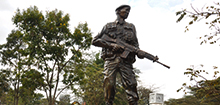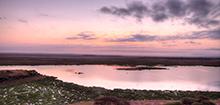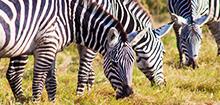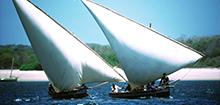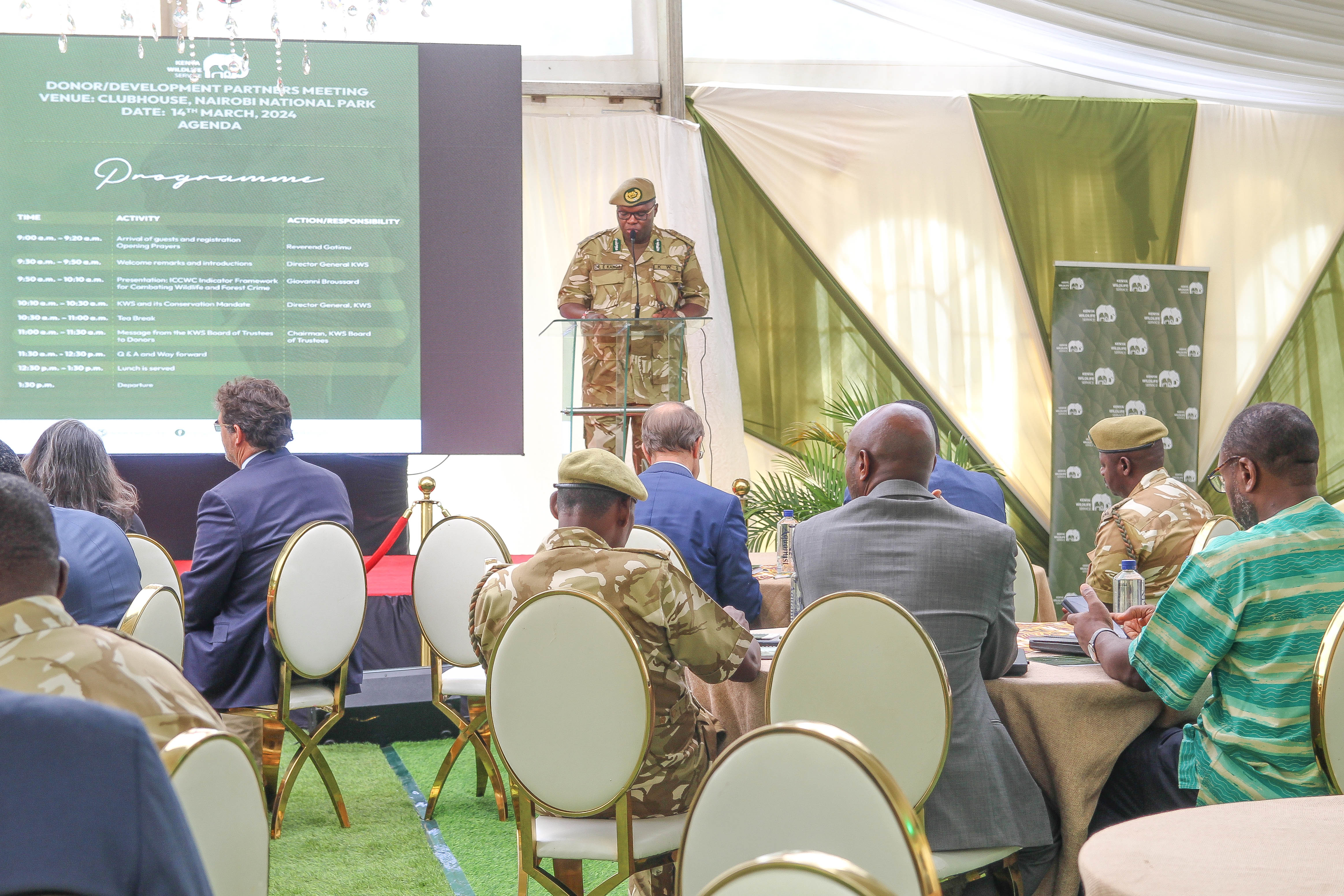
Date Published:
In an effort to deepen collaborative conservation, the Kenya Wildlife Service (KWS) Board of Trustees, Director General and Senior Management held a strategic meeting with key donors and partners at the Nairobi National Park’s Clubhouse, Thursday, 14th March, 2024.
In attendance at the meeting were several representatives from various donor and development partners, such as United Nations Environment Programme (UNEP), U.S. Fish and Wildlife Service (USFWS), US State Department Bureau of International Narcotics and Law Enforcement, United Nations Office on Drugs and Crime (UNODC), German International Cooperation (GIZ), Norwegian Embassy, U.S. Agency for international Development (USAID), The British High Commission, Agence Française de Développement (AFD), U.S. Embassy and the European Union (EU).
Speaking to the development partners, KWS Board of Trustees Chair Lt. Gen. (Rtd.) Walter Raria Koipaton explained that the Board is tasked with the responsibility of guiding and supporting management to attain its goals. He commended KWS DG Dr. Kanga for his efforts in restoring the Service to its former glory. Koipaton said that KWS had not had a board for the past several years, which reduced the Service’s effectiveness and ability to work towards its mandate, but now has a complete, 11-member Board. “We ask that you partner with us because we want to stand out in terms of integrity and prudent utilization of resources,” Koipaton said, adding that the Board members’ impressive qualifications in terms of experience, integrity, accountability and governance, address the core values of KWS.
The Chairman said that KWS rangers deserve special recognition for working under challenging circumstances to conserve Kenya’s wildlife, adding that a lack of integrity in the Board or Senior Management results in a demoralized ranger force. He stressed that KWS’ priority conservation partners are the communities, who are the eyes and ears of the Service, asking what returns they garner from wildlife. He appealed to the partners to continue to support KWS to address some of the social challenges arising from proximity to wildlife.
Board member Peter Moll said that the meeting signified a homecoming as well as an appreciation of the partners who continue to walk with KWS. He said that KWS needed partners to hold her hand so that the big landmass under the Service, the biodiversity and natural capital richness propel the Service towards ‘KWS 3.0.’
“Dignity for community and Community Social Investment (CSI) means incentivizing them to ensure their tolerance for wildlife is restored,” Moll said, adding that the Service needs to explore and invest in better technology, as well as engage and include the youth to foster a strong institutional memory.
Board member Chris Foot said that KWS’s biggest mandate was to protect Kenya’s biodiversity. He said that the world’s focus was on net zero, carbon and climate change, and the biggest concern - for those focused on biodiversity - is the substantial resources being channelled into climate change, which are necessary, but should not be at the expense of biodiversity. “They have to go hand-in-hand, and as you review your policies, please put a voice for biodiversity,” he said, adding that KWS needs partner assistance to develop conservation models for the global South, because for far too long, focus has been on the global North. He stressed that with the new DG and his team, past blips have been dealt with, assuring the partners of transparency, going forward.
Mr. Foot said that the elephant in the room was the pressure being exerted on KWS from County governments, of taking over the parks and reserves under its jurisdiction, or expecting – quite rightly – a higher return of benefits-sharing. “That is something that is not going to go away, and we are torn, as KWS, in ensuring that we protect our biodiversity, a national asset, and ensuring that the people who have looked after it for millennia benefit from it as well,” he said, adding that while most of KWS parks do not provide adequate income, the Service protects biodiversity because of its innate value.
Mr. Foot also spoke about bio piracy challenges and how frustrating it is for donor funds to be channelled through tertiary bodies. He said that some of KWS’s asks include building up far-flung parks such as Meru and Sibiloi, which don’t attract tourism revenues. He said that the Nairobi Animal Orphanage and Safari Walk were slated to be relocated to a new site, which provides donors with opportunities on how the Service integrates education, captive breeding programs and veterinary activities. Mr Foot said KWS should have an innovation hub, not only for technology, but also for ideas, with donor support, to bring forth global solutions for the global South.
Making a presentation to the partners, KWS Director General Dr. Erustus Kanga said that the objective of the meeting was to strengthen conservation through partnerships, by encouraging transparency and accountability in the Service’s processes.
Dr Kanga stated that KWS is governed by a Board of Trustees. He explained the rationale behind the Service’s establishment in 1989, as a uniformed and disciplined service, against a background of heavy poaching, with the core mandate of conserving wildlife in Kenya and enforcing related laws and regulations. A consortium of partners injected more than $500 million (equivalent to $2.5 billion today) which played a significant role in reversing poaching trends, protected areas development, establishment of a community wildlife dimension, creating conservation programs - such as the Elephant and Lion programs - and strengthening institutional capacity.
On facing the future, he wondered if armed rangers was the narrative KWS wished to continue with. The DG said that the Service’s mandate should now focus on penetrating communities, because KWS is responsible for 20% of all land in Kenya. This includes 154 stations outside protected areas, four marine national parks, eight national sanctuaries, six marine reserves, 23 terrestrial national parks, 29 terrestrial national reserves and 215 community conservancies, the latter of which are a creation of KWS.
Dr. Kanga said that although there has been a massive decline in Kenya’s biomass of wildlife from 2010 to 2022, commensurate with human population growth, wildlife populations remain strong within protected areas, hence the need for the Service’s outreach to communities, which deserve to benefit from their proximity to wildlife. Dr. Kanga said that in 2021, elephant populations grew from 16,000 to 36,000, some of which live on community land. Rhino populations also saw remarkable recovery over that period, from 900 to over 2,000. Conversely, dwindling mountain bongos, roan antelope and the sable antelope populations require the formulation and implementation of species recovery plans; an area in which partners are required.
Dr. Kanga averred that human-wildlife conflict is the biggest conservation challenge, engendered by competition for space. These conflicts happen in areas outside protected areas and conservancies which are community lands, in which KWS has been able to mark hotspots, which are mostly wildlife dispersal areas or corridors. He explained that human-wildlife conflicts lead to human deaths and/or injuries, crop damage, livestock predation and property damage. “Although the Service has in place mitigation measures such as the Problem Animal Management Unit (PAMU), translocations, compensation and creation of conservancies, the implication of this challenge cannot be ignored,” Dr. Kanga said. Cases of intolerance to wildlife in the communities, retaliatory wildlife killings - especially of elephants in higher numbers than seen with poaching, poverty in families whose bread winner has been killed or injured through human-wildlife conflict, pose vastly different challenges for KWS today, compared to 1989. The DG said that it would be an uphill task for KWS and partners to inculcate community acceptance of wildlife in light of current circumstances.
Dr. Kanga lamented the explosion of motorcycle use in ferrying bush meat, which has expanded the illegal activity from subsistence to commercial hunting, using snares instead of guns. Human-wildlife conflict and bush meat hunting are tied to community livelihoods. He said that if communities’ livelihoods were grown, there would be improvement in the way humans and wildlife co-exist. Other conservation challenges faced include loss of space, pollution, declining populations, climate change and invasive species.
The DG said that KWS conserves four out of five water towers – Aberdare Ranges, Mt. Kenya, Mt. Elgon and Chyulu Hills. All water in Nairobi is from Aberdares. If KWS did not conserve the Mt. Kenya landscape, there would not be the 67% hydro power from the Seven Forks Dam. Hell’s Gate National Park is the main source of Kenya’s geothermal power, from which KWS does not benefit much. “KWS is a climate change action institution by dint of covering 20% of Kenya’s landmass”, he said. Further, one in every 10 jobs in Kenya is in the tourism and wildlife sector, such as in the hotel industry and Eco lodges. “Supporting KWS means supporting much more than meets the eye,” he concluded.
Mr Giovanni Broussard, environment team leader at UNODC, explained the results of a SWOT self-assessment conducted some months ago on how Kenya manages and responds to the issue of wildlife crime. Mr. Boussard lauded Kenya as being one of the countries that has registered significant progress in building up responses to wildlife crime over the last 15 years. He expressed gratitude to the EU for their financial support.
Some of the factors assessed included the law enforcement capacity to arrest poachers and traffickers, capacity to prosecute, and judicial awareness. Some weaknesses include; lack in follow-up investigations in wildlife crime, legislation on forestry crimes and sharing of information across different agencies. Mr Boussard also mentioned that the issue of bush meat needs to be properly addressed, and said that the wildlife legislation in existence has sufficiently deterrent penalties, in some regards. “The level of multi-agency co-operation in terms of investigation continues to improve,” he said, congratulating KWS for becoming a member of an important taskforce, alongside the DCI, and adding that there is a need for increasing training for prosecutors and sensitizing judges.
Other KWS Board members in attendance were Tom Silvester – CEO of Loisaba Conservancy, and Mercy Muthoni Maina.

